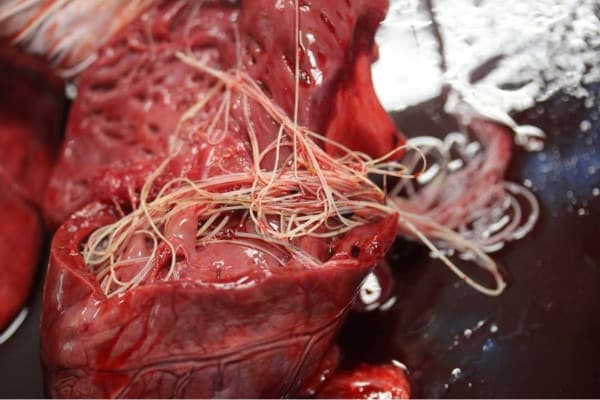As I prepare for my appointments next week one of my procedures is initiating heartworm treatment on a young dog. It is January and I am treating heartworm…I am nervous about treating this dog who’s heart is enlarged from the disease and has changes to the lungs. Treatment is necessary but may also cause a lot of complications and potentially kill this dog. So I find in necessary to write another blog about this disease since there are so many owners in the area who do not give heartworm prevention year round.
Dirofilaria Immitis (Canine Heartworm)
Dirofilaria immitis (canine heartworm) is transmitted by over 60 species of mosquitos. This disease is present worldwide, in the United States it is more prevalent in the East and South but disease has been documented in all of the continental states. Outdoor dogs are 4-5 times more likely than indoor dogs and infections in a given dog range from 15-250 worms. Adult female worms live in the pulmonary arteries and release live young (microfilaria) into the circulation which can circulate for 3 years. Mosquitos are intermediate hosts and upon feeding on animals they inject a larval stage into tissue. The larva migrate through soft tissue and into circulation. Here they mature into mature adults and begin releasing live young into the blood stream about 6-9 months after the initial infection. There is no consistent relationship between the number of worms and the severity of disease that develops.
The parasites cause damage to the pulmonary arteries, lungs, the muscle of the heart, causes pulmonary hypertension, thrombus formation, increased vascular permeability and interstitial and alveolar edema. The worms also release substances that prevent vasodilation and cause constriction of the bronchi. This causes inflammation decreasing oxygen transfer and my lead to irreversible fibrosis in the capillary beds. Blood flow becomes impaired and can lead to acute heart failure. The worms also carry their own intracellular bacteria (Wolbachia) which contribute to the pathogenesis of heartworm disease.
At the time of diagnosis most dogs are acting normally with no signs of illness. The physical exam can vary but is generally normal. Diagnosis includes a positive antigen test, a second positive Ag test at a lab, and identifying the presence of microfilaria. After the diagnosis is made full lab work and chest x-rays are used to help determine the severity of the disease prior to starting therapy for the parasites. The risks of complications associated with treatment increase when changes to the heart size and shape and changes to the lung tissue are present. If the dog is showing evidence of heart failure at the time of diagnosis referral to a cardiologist may be recommended for treatment.
No treatment is 100% effective but, with therapy, signs of illness and respiratory function can be improved. After staging treatment starts by starting a monthly parasite prevention to start to kill any microfilaria. It also included antibiotics to kill the Wolbachia present in the worms- if microfilaria are present or there are changes to the lungs steroids may also be used during this time. This is followed by a 30 day waiting period to allow the body to rest prior to starting treatment to kill the adult worms. The next step in treatment is adulticide therapy, Melarsomine. Melarsomine is an injectable medication that is given deep in a back muscle. This injection is very painful for dogs. The first injection is given and the dog is kept in the office for the day for monitoring. Two more injections are administered the following month (three injection protocol).
Once treatment is started dogs need to be strictly rested as worms are dying in circulation- exercise increases the risk of causing an embolus and acute respiratory distress.
Monthly prevention is safe, effective, and more cost effective vs treatment for heartworm disease. Over the years I have heard may reasons from pet owners for not giving prevention; the age of the pet, having other diseases, and being worried about side effects of prevention to name just a few. While no treatment is risk free there are so many forms of prevention on the market that even if your pet as an adverse reaction to one type we will be able to try a different one. As for geriatric pets and pet with concurrent disease (like cancer) — these are the population of animals that we should be very diligent in using prevention because if treatment for heartworm disease is need they are more likely to suffer severe complications. So yes, the 14 year old dog with kidney disease, a heart murmur, thyroid disease, and has had cancer (this is my own dog) should get monthly prevention. If your pet is not currently on parasite prevention please talk to your veterinarian about safe and effective options to prevent this horrible disease.


 Barks & Recreation is proud to feature Dr. Eileen Savier CVA, CVCH as our Veterinary Blogger in our “From the Vet” Series — offering information related to the health and welfare of your furry family members! Currently part of the team of doctors at Keystone Veterinary Clinic, Dr. Savier is a 2012 Graduate of the Ross University School of Veterinary Medicine, She completed her clinical experience at The Ohio State University and after veterinary school she pursued further education and certification in Veterinary Acupuncture, Chinese Herbal Medicine, and Fear Free veterinary visits. Dr. Savier has a special interest in integrative medicine, animal behavior, and internal medicine and is committed to improving animal health care by integrating Eastern and Western philosophies. She enjoys working with fearful & aggressive dogs and cats and she has had additional training in low stress handling techniques and encourages positive reinforcement during exams and procedures. Her clinical interests include pain management, animal behavior, geriatric patient care, and internal medicine.
Barks & Recreation is proud to feature Dr. Eileen Savier CVA, CVCH as our Veterinary Blogger in our “From the Vet” Series — offering information related to the health and welfare of your furry family members! Currently part of the team of doctors at Keystone Veterinary Clinic, Dr. Savier is a 2012 Graduate of the Ross University School of Veterinary Medicine, She completed her clinical experience at The Ohio State University and after veterinary school she pursued further education and certification in Veterinary Acupuncture, Chinese Herbal Medicine, and Fear Free veterinary visits. Dr. Savier has a special interest in integrative medicine, animal behavior, and internal medicine and is committed to improving animal health care by integrating Eastern and Western philosophies. She enjoys working with fearful & aggressive dogs and cats and she has had additional training in low stress handling techniques and encourages positive reinforcement during exams and procedures. Her clinical interests include pain management, animal behavior, geriatric patient care, and internal medicine. Dr. Savier shares her home with two (soon to be three) dogs, two cats, and a toddler. She lovingly refers to her two dogs as Coconut Retrievers as they were rescue dogs she brought home from the island of St. Kitts. In her free time she enjoys spending time with her family, going to the beach, and planning her next Disney vacation.
Dr. Savier shares her home with two (soon to be three) dogs, two cats, and a toddler. She lovingly refers to her two dogs as Coconut Retrievers as they were rescue dogs she brought home from the island of St. Kitts. In her free time she enjoys spending time with her family, going to the beach, and planning her next Disney vacation.




